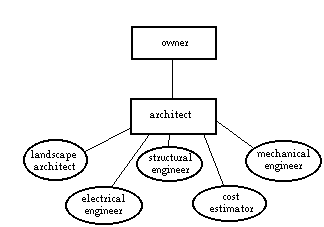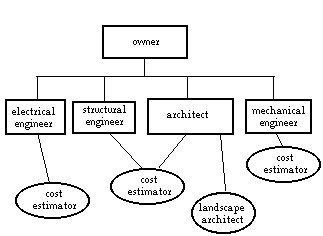|
ARCHITECT AND ENGINEER CONTRACTS
|
©2000 Fred Tepfer 1380 Bailey
Avenue Eugene, OR 97402 |
Although many smaller school districts sign standard contract forms from the American
Institute of Architects, larger districts and other owners with regular experience
in design and construction take a number of measures to protect their interests
while working with architects and engineers. In any case, an experienced construction
contract attorney should review any contract for a substantial sum.
Hiring
Projects begin with planning, then move into design and construction. As this
process progresses there is more and more certainty about the parameters of
the project, what it consists of, where and when it will be built, how it will
be paid for. Often, to begin this process, a planning study or project definition
study must be done even before you know that you want to build. These initial
contracts are often small, but still would fit into the category of architect
and engineer contracts.
School districts are famous for making hash of the architect hiring process.
The classic horror story is that the district starts the hiring process wanting
to save a great deal on fee, and hires the architect whose proposed fee is lowest.
Said architect gives relatively poor service, as per their compensation. Owner,
near the end of the process, feels wronged by lack of choices, poor design,
hasty construction documents, or whatever, and sues architect.
How can this nightmare be avoided? Most larger government agencies, as well
as the Federal government, use some form of qualification-based selection process.
In this process, the owner hires following these steps (or some variation of
them):
1. The school or district establishes a hiring committee and procedures. The
committee prepares information describing the project (a request for proposals,
or RFP), the site, the budget, and any other pertinent information. This may
require some work. The district may want to hire an educational facilities planner
to help with this process. If the district has determined that a certain fee
is reasonable for this work, the fee is described as well. It is made clear
that this is not a design competition, and that design will not begin until
after a contract has been signed.
2. In response to advertisements, architects submit proposals. The district
reviews those proposals accrording to the criteria outlined in the RFP, either
using a point system or at least by documenting their reasons, which most often
relate to experience, size, availability, proximity, or references. If the district
has a budget for architectural fees, the anticipated amount is clearly stated
in the request for proposals.
3. A certain number of firms are invited to an interview (usually at least three,
most often no more than five or seven). If references weren't checked when the
proposals were reviewed, it is important to check them now, and to forward the
information to the committee members (see References, below).
4. After the interviews (usually 30-60 minutes in length), the committee deliberates,
and, documenting why, forwards a recommended list of firms in rank order to
the district.
5. The district negotiates fee and service level with the preferred firm. If
they are unable to come to terms, the district breaks off negotiations and begins
negotiating with the second firm. During this process, it is important for both
sides to understand the expectations and committments. Sometimes architecture
firms offer services which the owner neither wants nor is willing to pay for.
Other times, the owner expects certain services to be included in the architects
proposal which may not be there.
References
Reference checking is a fine art. It is wise to make more than one
check on each firm, and at least one of those should be a reference not listed
in the firm's proposal. Make sure that the project references checked were the
work of the same people in the firm, as a firm's performance can vary widely
depending on the personnel assigned to the project.
References can prevent you from hiring a firm that would be a bad fit for your
project. They can also warn you about weak points in a firm that you might be
about to hire. For example, if you find that an otherwise excellent firm has
an unfortunate tendency to change the personnel assigned to a project while
it is underway, you may want to include a clause in their contract that prevents
them from doing that without your permission (naming the people by name).
One bad reference need not prevent you from hiring a firm. Every firm has a
project that has gone sour. If you do get a bad reference, it is important to
continue checking until you are confident of the pattern that is emerging. What
is this firm like? Do you want to work with them? What are their strengths and
weaknesses?
Remember that reference information is confidential. It is considered very unprofessional
to discuss a reference conversation with an outside party who is not part of
the hiring committee.
The following reference check questions are used at the University of Oregon
Planning Office.
REFERENCE QUESTIONS FOR PROSPECTIVE CONSULTANTS
- Get name, position, and current status of person being interviewed.
- How many projects have you worked on in which this firm has been involved?
Size of project? Budget? Dates?
- How did you come to select this architectural firm?
- Who were the principals in the firm most directly involved in your project?
- At what point did you become involved in this project? In what capacity?
- Did you deal with the architects directly? Who talked with the architects?
(How many meetings? / How often?)
- Were you part of a team, committee, user group, a principal?
- Do you have a standard design and planning process?
- Was the firm (or its principals)
- Easy to work with?
- Concerned with your needs to the expected degree?
- Good listeners?
- Good advocates for the owner before contractors, public bodies, etc.?
- Good at recovering from mistakes?
- Did you get what was promised in the interview? People/Process/Product?
- Was the design team consistent?
- Did they see the project all the way through to completion and during the
"break-in" period?
- What was the biggest architectural problem you faced upon beginning the
project? Did the firm resolve this problem to your satisfaction?
- Did the architect recommend any unconventional building techniques or materials?
Were these successful? If not, how much of that responsibility is the architect's?
- Were there any surprises regarding their fees? Any unexpected extra charges?
- Did the architect's estimates come close to the actual bids?
- How was the quality of their work with their consultants?
- Do you like the building? Does it work as it ought to? Did you get the building
you thought you were buying?
- What don't you like about your building? To what degree is that the architect's
fault?
- What do you feel the general over-all reaction has been to the project? Have
you received any public feed-back?
- What was the biggest trouble in working with these architects? Were there
any hassles or arguments that were difficult to resolve?
- Who else should I talk to who can tell me more on these architects?
- Have you hired this firm again?
- Would you hire them again?
- Make an offer to someday reciprocate the reference.
WHAT'S IN A CONTRACT?
It is very important for a contract to clearly spell out what is expected
of each party. Here are a few questions that should be considered. How much
is the compensation, and at how and when does payment occur? How and when can
the contract be terminated? What are the basic services covered? How are extra
services (for extra fee) incurred? Who has what rights to the plans or other
product? Is the owner responsible for all survey information (incuding information
about existing buildings)? If the bid price exceeds the estimate by a certain
percentage, will the architect or engineer modify the plans and specifications
to bring the project within budget without charge to the owner?
Even if your district doesn't want to go through the effort of carefully working
out details of the contract, be sure that the following provisions are not onerous.
They are listed here because they have been problems in cases where districts
have signed (and regretted) standard contracts.
Termination: This provision should allow for termination without penalty
at the end of each major phase of design (schematic design, design development,
construction documents, construction administration). Upon termination, owner
should owe architect for the entire amount for that phase, and no more.
Insurance: A provision should clearly require the architect to maintain
Comprehensive General Liability as well as Errors and Omissions in amounts suitable
to the size of the project.
Extra services: These should be allowed only when approved in advance
in writing by the owner .
Construction cost: The contract should clearly state how much the construction
is expected to cost, usually expressed as the anticipated bid amount. Most contracts
require the architect to modify the plans as needed to stay within this amount.
Design control: It is important to include language requiring owner's
approval at the end of each design phase, and language requiring written authorization
from the owner before proceeding with the next phase.
The following link goes to a sample contract used by the University of Oregon
for a large project. It contains language which addresses the above issues.
TRADITIONAL OWNER/ARCHITECT AGREEMENT
In this arrangement, the owner has a contract with the architect.
All of the other design professionals have contracts with the architect. The
architect has full responsibility to the owner for all design responsibilities.
 |
Advantages:
Owner only needs to deal with one entity, the architect.
Disadvantages:
Architect may want to use engineering or other consultants that the owner
doesn't want.
Owner doesn't have direct access to some team members. All information is
filtered through the architect. |
MULTI-PRIME AGREEMENTS
Multi-prime agreements are sometimes used in large or very specialized work. In these
agreements, the owner has separate contracts with some or all members of the design
team. Some firms may have subcontracts with a prime firm (as the landscape architect in the example above). In most cases, the owner has hired these firms separately
and has imposed a team structure on the players. Each professional firm that has
a contract with the owner has direct responsibility to the owner. The architect's
contract usually includes a requirement that they coordinate the work of all of the other
firms, but since they have no contractual relationship with some of the other team
members, the owner may have to arbitrate disputes.
 |
Advantages:
Owner can select team members that they want.
Critical team members can be directly responsible to the owner.
Disadvantages:
Responsibilities may be confused, especially in the area of coordination.
Owner is the only means of resolving disputes between team members. |
RETAINER AGREEMENTS
Some owners maintain retainer agreements with architects, engineers,
or landscape architects. These are especially useful for small projects or emergency
work, as the contract is already in place, and no hiring process other than
agreement on fee is required before undertaking a project. If you use retainer
agreements, it is important to limit their duration (usually one to three years).
It is probably a good idea to "spread the work around" either with retainer
agreements with more than one firm at a time, or changing from one firm to another,
in order to foster a competitve environment.
return to index of School Facilities readings

